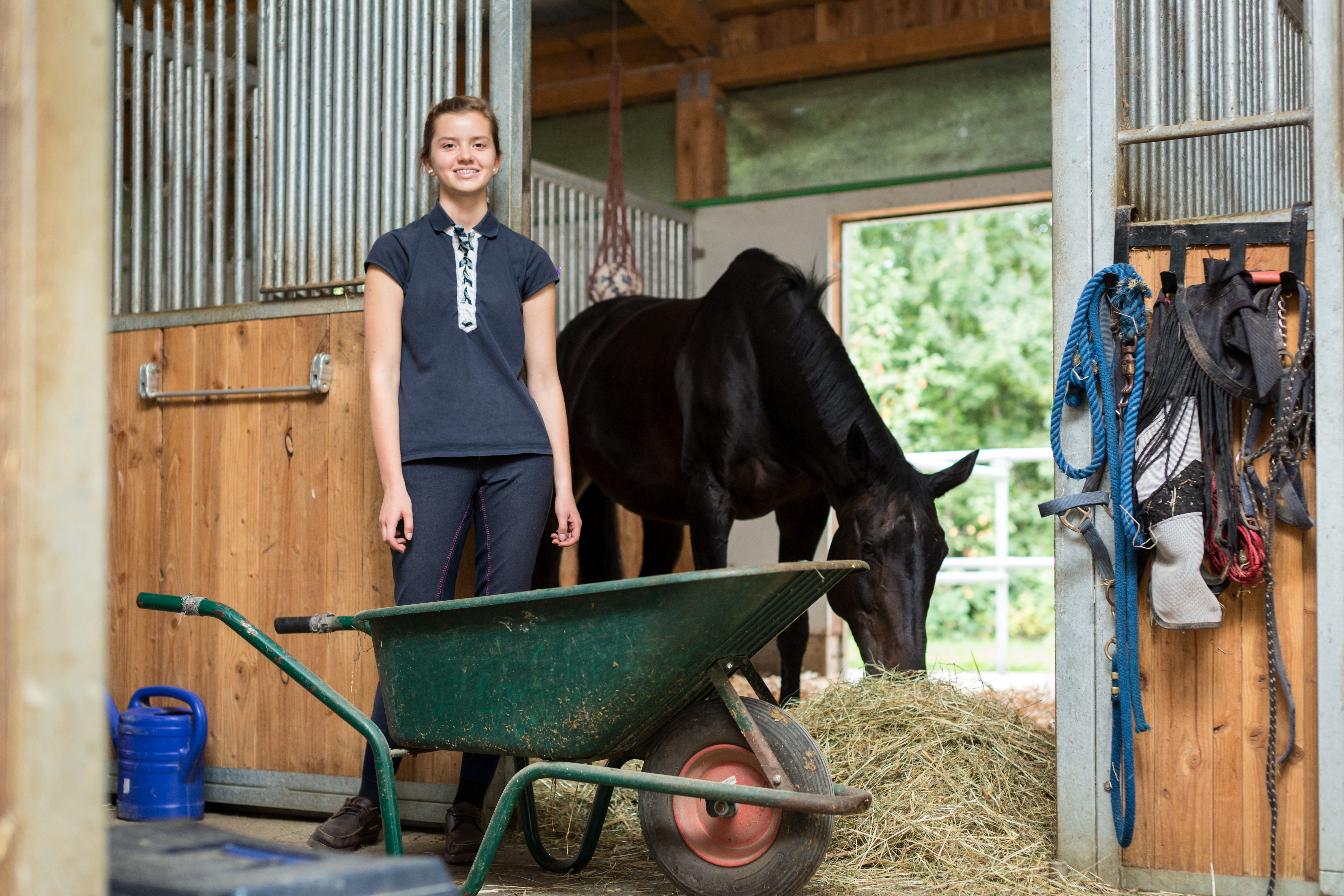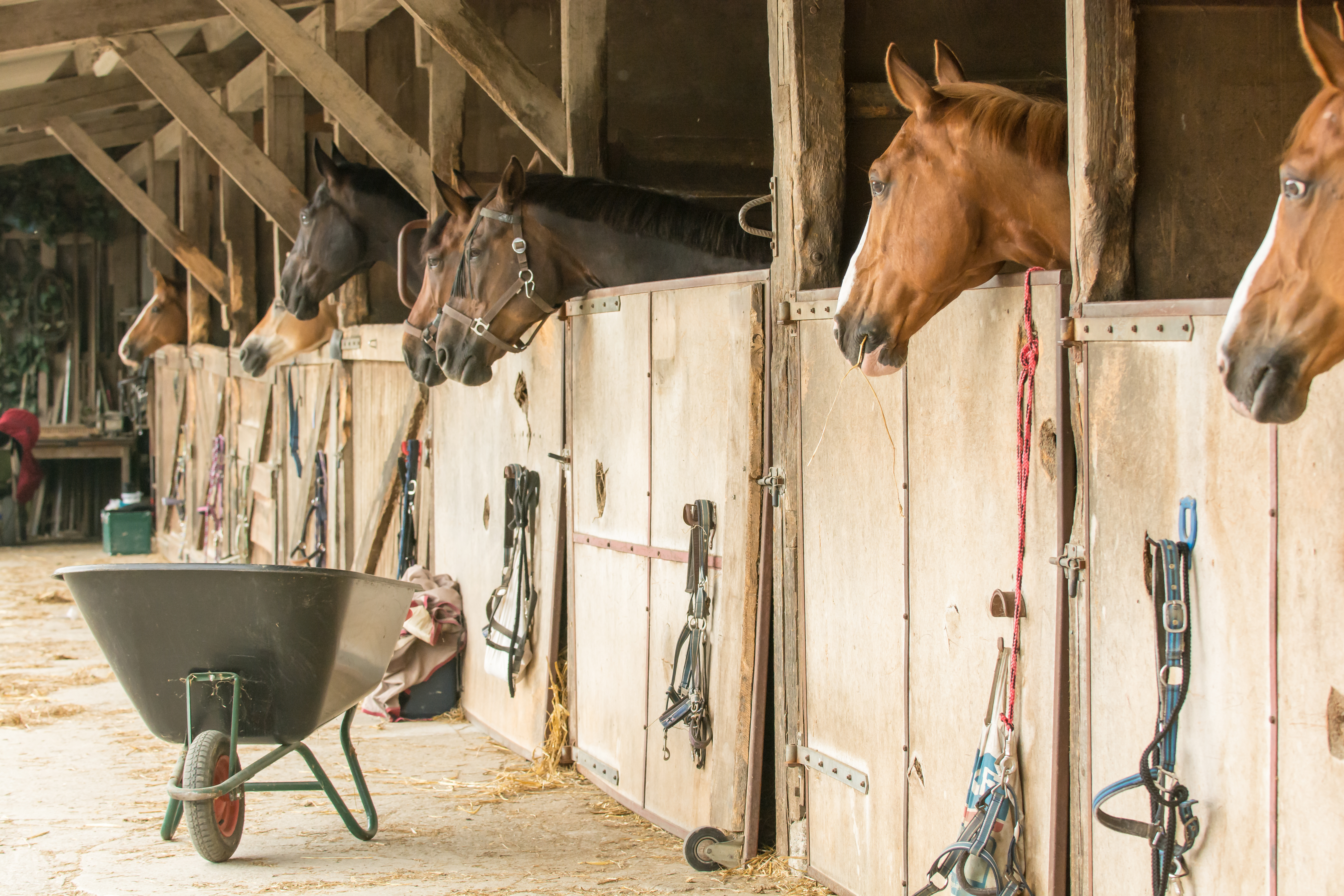Home > Horse Care > Which wheelbarrow is right for your barn?
Which wheelbarrow is right for your barn?
- May 17, 2023
- ⎯ Eliza R.L. McGraw
Caring for horses means spending a good bit of each day moving materials from one place to another. There’s feed to carry down the aisle and distribute to each horse, and hay to deliver to the stalls and paddocks. The manure needs to be taken out to the pile, and new bedding hauled in and distributed. Small wonder, then, that we depend so much on wheelbarrows, carts and wagons.

As simple and common as these tools are, they come in a variety of sizes, materials and styles. Most were designed for use at construction sites or in home gardens, and the best model for your horsekeeping needs may not always be obvious. In fact, at many horse barns you’ll find more than one wheelbarrow or cart, each dedicated to a different job.
The key to selecting the right wheelbarrow or cart for your situation is to match specific features to the jobs you do and the conditions under which you work. You well know what you need to accomplish each day around the barn. Here’s what’s available to assist you.
The difference between wheelbarrows, carts and wagons
A wheelbarrow, that familiar form with one wheel set at the front of a curved carrier tray, has long been used for mucking stalls and carrying bags of feed and bedding. Its single front wheel makes it easy to negotiate tight turns through doorways and around obstacles. The rounded, sloped front of the carrier tray is ideal for dumping loads of loose material, such as manure or shavings, and it’s easy to clean with a hose.
However, the shape of the tray can be clumsy for carrying flat or bulky items. It takes physical strength to lift and push a loaded wheelbarrow as well as a bit of dexterity to keep it upright. The single-wheel design can tip readily, especially when the wheelbarrow is pushed over uneven terrain. Some models have two wheels placed side by side at the front of the carrier; these provide more stability under heavy loads but require a larger turning radius.
Click here to see what your stall-cleaning style says about your personality.
A garden or utility cart has two distinguishing features: a relatively flat bed suited to carrying stackable items such as hay bales and bagged feeds, and two wheels–one on each end of an axle positioned under the carrier tray. Carts are also more stable and less prone to tipping than traditional wheelbarrows, and because the load is balanced over the axle, more of the weight is borne by the wheels, so it takes less strength to lift and move it. Many are designed to be pulled rather than pushed–making them easier for some people to manage. However, carts require a wider turning radius than a wheelbarrow and may be difficult to maneuver in close quarters.
Some utility carts have plastic carrier trays with slightly curved sides; others have straight-sided, rectangular trays with flat beds made of metal or wood. Many carts also have release mechanisms for dumping their loads.
A feed cart is designed for hauling grain and other processed feeds to farm animals. Most are plastic, with a single tublike container set upon wheels. Some have two wheels with supporting legs; others rest on three or four wheels. Several feed carts designed specifically for feeding horses have multiple compartments to hold different concentrates and/or supplements, so each horse can receive a customized portion as the cart is moved down the aisle.
Some models, which are also called chore carts, have very deep, large-capacity tubs. These are designed for transporting a large amount of feed that will be dumped in one place, such as a trough for swine or cattle. A person using one to feed horses would have to reach all the way to the bottom to scoop out the last of the grain.
A wagon is a four-wheeled vehicle, usually pulled by a single handle, that can carry much heavier loads, some as much as 2,200 pounds. Because all of the weight rests on two axles, no lifting at all is required to pull the load. Some also have removable sidewalls, so they can be converted into flatbeds for bulky items. However, having two axles spaced at the front and back of the load means that maneuverability in tight spaces is difficult.
A dolly, or muck bucket cart, is a metal-framed cart, often with an adjustable handle, designed to hold one or two 70-quart buckets. This can be a lightweight, inexpensive alternative for someone with only one or two horses, but it probably doesn’t offer enough capacity for someone who has to muck and feed a full barn.
Heavy vs. light duty wheelbarrows and carts
Wheelbarrows and carts are typically divided into two categories: those for homeowners, and those for contractors or industrial use.

The contractors grade models, called heavy duty, are designed to withstand daily use with larger, heavier loads. They have a sturdy construction, typically with added steel supports for the underside and a heavier gauge plastic or steel for the carrier tray. These models are built for a larger capacity (six to 10 cubic feet) and are more expensive (roughly $200 to $500). It takes more muscle to use them when they’re loaded, but these wheelbarrows will withstand years of punishing use and are the better choice for hard, daily work.
The homeowner models are intended for occasional use in landscaping or yard work. They are lighter in weight and usually have a smaller capacity (four to six cubic feet); they are also less expensive (roughly $60 to $250). These models might be suitable for use in a small barn, or they might be preferred by someone who has difficulty handling heavier loads, but they won’t last as long when put to rigorous use.
Material options for wheelbarrows and carts
Plastic is often preferred for wheelbarrows or carts used in horse barns because it is versatile, durable and lightweight; it is easy to clean with a hose; and it requires little maintenance. Even so, with heavy use over time, plastic carriers may develop scratches, which can trap residues, and they can crack and break.
Metal trays, usually made of steel with some sort of protective coating, are stronger and more durable than plastic but they are also heavier and require more maintenance. These models are designed for jobs that require heat, such as mixing asphalt.
A word about wheels
Wheelbarrows come with two types of wheels:
Pneumatic tires, which look like miniature automobile tires complete with inner tubes, can handle heavy loads and are well suited for use on soft or loose ground. The wider the tire, the more smoothly it rolls over gravel, mud or sandy soil with minimal damage to the ground surface. Most are three or four inches wide, but some wheelbarrows come with tires as wide as six inches. The air cushion in the inner tube also provides a smooth ride and minimizes bounce over uneven terrain or obstacles such as doorsills or curbs.
Pneumatic tires are, however, prone to flats. It’s a good idea to keep a replacement inner tube on hand for repairs and to store a bicycle pump nearby to maintain tire pressure.
Solid or flat-free tires will never go flat. Some are molded from a single solid piece of hardened rubber; others look like pneumatic tires but are molded with tiny air pockets inside to cushion the load. These tires are designed for use at construction sites, where there may be screws, nails and other sharp debris scattered over the ground. This, of course, is not the case around the barn, but flat-free tires do save the maintenance issues associated with pneumatic tires. Solid tires can handle heavy loads, but they do tend to be harder and provide a rougher ride than the pneumatic tires.
Many models of wheelbarrow can be used with either type of tire, which can be purchased separately.
Some heavy-duty carts come with spoked wheels, which resemble those on bicycles. They have a wider diameter than other wheelbarrow tires, which makes them easier to pull over hard surfaces, such as barn floors or pavement, even when the cart is fully loaded.
These wheels are also easier to pull over very large obstacles, such as rocks or branches. However, spoked wheels cannot handle the heaviest loads, and because the tires are narrow, they are difficult to pull through, and will slice into, soft footing.
Test driving wheelbarrows
As good as a particular wheelbarrow or cart may look, you won’t know if it “feels” right until you try it out. The height of the handles and the way the carrier balances over the wheels will make a big difference in how easily you can use it. Also consider the height of the bed, and how high you’d have to reach or how low you’d have to stoop to load and unload it.
If possible, try out the models you are interested in at the store. Pile some weight–bags of mulch, for example–into the carrier tray and see whether you’re strong enough to handle it when it’s loaded. Don’t forget to check how readily it turns, especially if you’re considering a two-wheeled model.
Choosing the right wheelbarrow or cart for the task at hand can help you speed through your chores while avoiding an aching back and shoulders at the end of the day. And that will leave you more time to enjoy your horses.
Don’t miss out! With the free weekly EQUUS newsletter, you’ll get the latest horse health information delivered right to your in basket! If you’re not already receiving the EQUUS newsletter, click here to sign up. It’s *free*!





